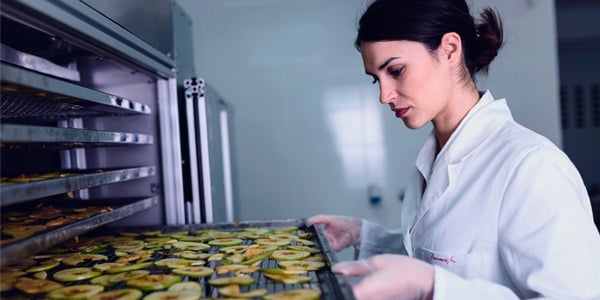Throwing food away has severe consequences, including environmental harm, starvation, and financial waste. Thankfully, there are plenty of methods you can employ to decrease food waste in your QSR—while boosting profitability. Read more here as we discuss sustainability strategies to help your QSR sustainability strategy.
The United States has a serious problem with food waste. Of the 229 million tons of food produced in the US in 2019, consumers, retailers, and restaurants wasted 35% of it. While charitable organizations donated some of this “surplus” to those in need, most of it wound up in landfills, incinerators, and sewers. Your quick service restaurant (QSR) sustainability strategy begins and ends with controlling food waste.
According to ReFED, 54 million tons (or about 24% of US food) are in landfills yearly. Almost 2% of US GDP rots away as a direct result of wasted and spoiled food. That’s roughly 90 billion meals!
Wasted food still consumes valuable resources to cultivate, harvest, chill, transport, prepare, and cook. Governments worldwide pledge to halve food waste by 2025 or 2030—but QSR franchisees can make moves today to bolster their sustainability strategy by reducing food waste in their businesses.
Food Waste in the US: From the Supply Chain to QSRs

Research shows that between 4% and 10% of products purchased by restaurants never reach hungry customers. This waste amounts to roughly $1,000 in earnings for every 3.3 lbs.
Owners and operators have several strategies to control prices, but they must also consider new techniques for managing waste. Profitability goes up when food waste goes down. Weathering the Inflation Storm: Business
America’s problem with food waste isn’t new either, and it’s not something one could blindly blame on Covid-19 and supply chain backups. A 2014 study found that 84% of uneaten food in America wound up in the garbage, while only 14% was recycled and 1.4% was donated. A 2012 study found that Americans threw away almost half their food, amounting to $165 billion in annual waste.
According to the USDA, the restaurant industry loses $162 billion annually due to waste. This waste usually stems from poor employee training, overproduction, over-ordering, inadequate food storage, and inefficient recycling techniques. Some franchisees might think adopting sustainability strategies will bite their profit margins, but that’s not necessarily true.
Implementing new systems may be challenging, but the cost-to-benefit ratio is well worth the effort. For every dollar spent on food waste reduction, owners can expect an average of $8 in savings. Customers also more frequently support businesses that show they care about food waste and sustainability. A Unilever study found that 72% of US diners cared about how restaurants manage food waste, while 47% were willing to spend more at businesses with an active food recovery program.
Restaurants aren’t the only ones contributing to the food waste problem. One can look at the entire food supply chain and find several areas needing a new sustainability strategy.
US food production makes up 15.7% of the entire energy budget. Meanwhile, 50% of all land and 80% of freshwater consumption goes towards food production annually. Still, farms lose 20 billion pounds of produce each year to waste. At sea, fishing boats discard an astonishing amount of catch, with the UN estimating that 8% of fish caught in marine fisheries are thrown back. Unfortunately, those “discards” are dead or dying fish that upend the ocean’s ecosystem.
Reducing Food Waste: Trends to Watch in 2022 and Beyond

There’s no denying the effects of food waste on hunger, the economy, the environment, and profitability. Like any industry, new technological trends emerge daily, aiming to cut back on waste and lost revenue. Industry executives can look forward to a future full of shelf life-extending technology, food waste digesters and dehydrators, and innovative kitchen equipment. Let’s explore some exciting trends to keep an eye on and how they’ll play a crucial role in your QSR sustainability strategy.
Track Your Food From End to End
SafeTraces, a startup dedicated to food sustainability, uses a safe-on-food solution they apply to products during the wash cycle. It’s an undetectable and edible tracking solution that gives you an end-to-end look into a product's journey from farm to shelf. This technology allows companies across the supply chain to protect their brands, reduce food waste, and understand where issues occur before ingredients ever make it to the restaurant.
Another company called Zest Labs currently leverages sensors to gather harvest quality, age rate, field condition, and microclimate data to determine how long products will last. Up-front data gives restaurant owners deeper insight into shelf life, supporting their sustainability strategy through more robust freshness management. Those same sensors attach to the transport pallets to determine where waste occurs in the supply chain. Reports from Supply Chain Dive indicate that such sensors can reduce food waste by 7%. QSR owners must be ready to invest in shelf life-extending tech, especially if the umbrella franchise pivots in that direction.
Digest Your Waste In-House
One trending sustainability strategy currently leveraged by Purdue University, Marriott Hotels, Boston Medical Center, and Disney World is using food digesters to cut down on waste. Also known as food waste liquefiers, these machines grind discarded food before breaking it up with a biological additive to expedite decomposition. These natural additives include enzymes, microbial organisms, or a mix of both. Once decomposed, food digesters add fresh water into the mix before disposing it into the sewer.
A Hard Rock Cafe in London reported a 56% drop in waste disposal costs while saving 9.7 metric tons of CO2 emissions after converting to food digesters. The technology can save the industry over $3 million in annual waste-hauling costs and can prevent over 25,000 metric tons of CO2 emissions each year.
Food digesters provide several sustainability benefits. Since there are no solids to dispose of, discarding unusable food becomes more efficient. You don’t have to haul rotting solids to the landfill, as the liquidized food gets mixed in with wastewater. There are also fewer odors associated with discarded food. All QSR owners know how bad the dumpster can smell by the end of the week.
It’s worth noting that the byproduct of digesters can corrode plumbing due to higher biochemical oxygen demand (BOD). It can also harm local wastewater treatment systems, so check with your local authorities to ensure they can handle it.
... Or Dehydrate It

Food dehydrators take the opposite approach. Instead of adding water to food waste, dehydrators remove moisture to reduce weight and volume. First, the dehydrator shreds food waste and uses heat to evaporate moisture. Once you remove all the water, you’re left with a mound of dry scraps. The liquid waste goes down the drain with minimal levels of BOD, while the dry remnants go in the trash. Organizations like IKEA, The Brisbane Convention & Exhibition Center, MIT, and Hyatt International leverage dehydrators in their sustainability strategy.
It’s All About the Data
QSRs are in a highly-competitive market, doing everything they can to boost profits quarter after quarter. Reducing waste is among the best ways to increase profitability, but QSR owners must take the appropriate steps to recognize waste in their processes. Data analytics is crucial for measuring how much trash you generate.
A London company called Winnow leverages AI-enabled solutions to gather data on food waste. They place smart scales underneath trash bins to weigh the amount of garbage. Then, employees use a touchscreen to enter the type of food they’re throwing away. Meanwhile, state-of-the-art cameras and tech learn to recognize food as it's disposed of. The result is a detailed data set showing your food waste's financial and environmental impact. Now, you can adjust your purchasing schedule to reduce waste and save money.
Data analytics can also optimize your menu and inventory management strategy to reduce food waste. You’ll know which menu items perform well locally and at which time they sell the most. From there, you can adjust your operations to produce more during peak hours and less when it’s slow. For example, the data might tell you that high-energy and snack items are more popular after school or work, while your customers prefer quick eats at lunchtime.
Sustainability Strategy 2022: What Can QSR Franchisees Do Now to Reduce Food Waste?

Next to payroll, food costs are the second-highest expenditure in the hospitality industry. A sustainability strategy focused on reducing food waste is imperative to supporting your bottom line and achieving your business goals.
There’s never been a better time than now for QSRs to make food waste management a top priority. We’re spending more on food—but making fewer profits due to waste. What steps can QSR operators take today to improve their food waste management strategies?
First, let’s unpack the leading causes of food waste in restaurants before we dive into any actionable strategies. The four most common causes of food waste are:
- Spoiled Product: Improper handling, poor storage, and unsustainable packaging can cause food to spoil quickly. In QSRs, the leading examples include over-ordering, inadequate refrigeration, and poor inventory management.
- Oversized Portions: Your customers probably love big portions, especially if they plan to eat leftovers for lunch or dinner. But think of all the excess food that ends up in the trash (not to mention the plastic/styrofoam takeout containers). Portion control is crucial to your bottom line, and it begins with proper kitchen training and menu design.
- Spills and Accidents: Mistakes happen, like a server dropping a food tray or a chef knocking over their cutting board. While minor, these mistakes still lead to unnecessary waste.
- Refires: Food will also occasionally come back to the kitchen for a refire due to server, chef, or customer mistakes. Wherever the reason, refired food costs money and generates waste, especially if the original plate has already left the kitchen and can’t be used elsewhere.
Now that we understand where waste occurs, let’s go back to the basics to look at steps you can take to improve your sustainability strategy.
Waste Audits
Audits paint a clear picture of how much trash your restaurant generates based on your current systems. To conduct a proper trash audit, open the bags every day for a week and sort your garbage into the following categories:
- Paper goods (towels, napkins, flyers, and old menus)
- Takeout containers (cups, plates, and lids)
- Produce
- Meat (including fish and poultry)
- Plastics
- Other (broken plates, glassware, and any other miscellaneous items)
Once sorted, weigh each pile and record the results. Then, multiply that weight by the number of days your business opens yearly. That number tells you how much annual waste you can expect within each category and where you can cut down to save.
Inventory Par Levels
Ordering based on par levels can significantly reduce the amount of food spoilage in your kitchen. Par levels set the minimum amount of product needed to meet daily demand. It’s also wise to leave a small margin of error to account for demand changes.
You can easily base these par levels on your sales data. Modern POS systems can track and manage all your inventory data for you, making it easy to access and leverage. It’s better to run out of something than to throw away unsold food.
The FIFO Method

First-In-First-Out (FIFO) is mostly likely ingrained in your staff’s heads. FIFO ensures that the oldest food gets used first while the new product gets pushed to the back. This straightforward strategy can quickly reduce food spoilage. Every grocery store you’ve ever been to employs this method. The same should be true for your restaurant.
Start Building Your Sustainability Strategy Today
Throwing food away has severe consequences, including environmental harm, starvation, and financial waste. Thankfully, there are plenty of methods you can employ to decrease food waste in your QSR—while boosting profitability.
Your sustainability strategy doesn’t need to be overly complicated. Even simple best practices like FIFO are a strong start. Still, you can take your initiatives to the next level by investing in the latest technologies. Governments and organizations worldwide are making concerted efforts to cut back on food waste, and your QSR can be part of the solution.
Of course, investing in sustainable equipment and practices does come with some financial burden, which is why leaning on a trusted financial partner like Dubuque Bank & Trust, a division of HTLF Bank is crucial at every stage.
Get in touch with Dubuque Bank & Trust, a division of HTLF Bank today to speak with a commercial banker with deep industry insight. Together, your QSR can take the first step towards improving your sustainability strategy by cutting back on food waste.









